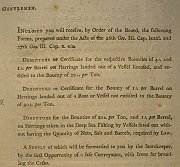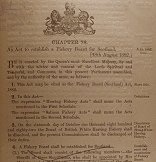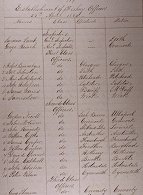Herring Home | Sale and Processing of the Herring | Filling barrels and Inspection| Herring export
Herring Legislation and the Fishery Board

Fishing has always been seen as important to the Government of Britain. They thought that a healthy fishing industry helped to control the country and its population. In the 18th century, they wanted to promote new developments in the fishing industry. In 1750 legislation was introduced giving tonnage bounties for the fitting out of herring busses. Herring busses were large boats on which herring was cured at sea after being caught. This legislation also gave customs officer's responsibilities to check the nets, salt and barrels. In 1785 a second bounty was introduced, it was given for every barrel of herring cured onshore. This new barrel bounty meant that small boats now qualified for the bounty. This new bounty quickly led to an increase in herring fishing, particularly in Caithness and on the Forth.

As the importance of the inshore fisheries was realised more attention was given here. The Fishery Board for Scotland was set up in 1809 and it introduced a system of fishery districts. Fishery officers were placed in each district. This was the foundation of a system still in operation.
One of the main aims of the Fishery Board was to improve the handling and curing of herring. This was an important duty of the fishery officer. He had to make sure that the strict regulations regarding size and construction of barrels were adhered to (link barrel section). He also had to check that the herring had not lain in open troughs and that they were properly gutted using a knife. The herring had to be salted and packed in barrels within 24 hours of being caught, and using the appropriate amounts of salt. Sorting of herring for packing was also encouraged. If he was satisfied, the officer branded the barrels with the crown brand as a guarantee of quality. Officers were recruited exclusively from coopers and curers because they understood the herring trade.
Bounties were phased out in the late 1820s but they had been successful in getting the Scottish herring fishery up and running. The system of inspection for quality control of the cure was continued. By the 1850s, Scottish herring had established a reputation on the main continental markets.

The biggest expansion in the herring fishery took place after 1850. New duties were given to the fishery officers at this time. More detailed record keeping was also introduced, including noting the 3 classes of fishing boats and the value of boats and gear. In 1868, an act requiring the registration of fishing boats was introduced. Fishery offices continued to be located around the coast, although offices were closed and new ones opened as fishing patterns changed. Herring fishing began to suffer badly after World War I and this continued through World War II. At this time more offices were closed and merged. More information about the development of the Fishery Board can be found in its published annual reports.
Herring Home | Sale and Processing of the Herring | Filling barrels and Inspection| Herring export